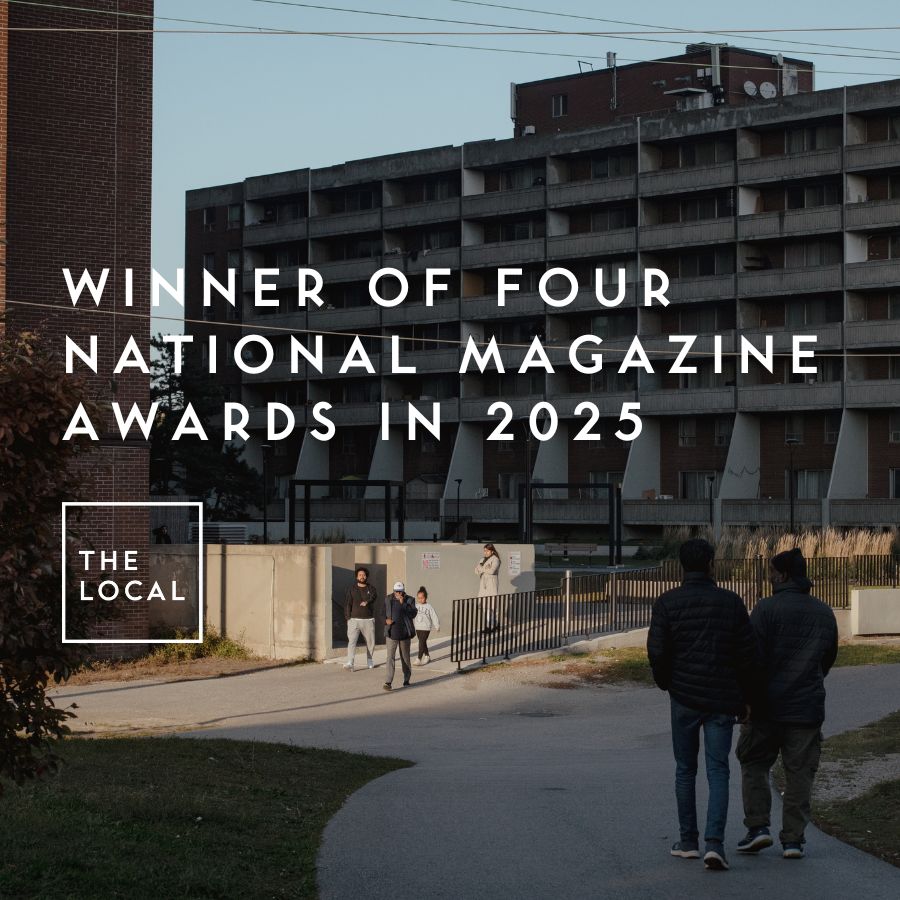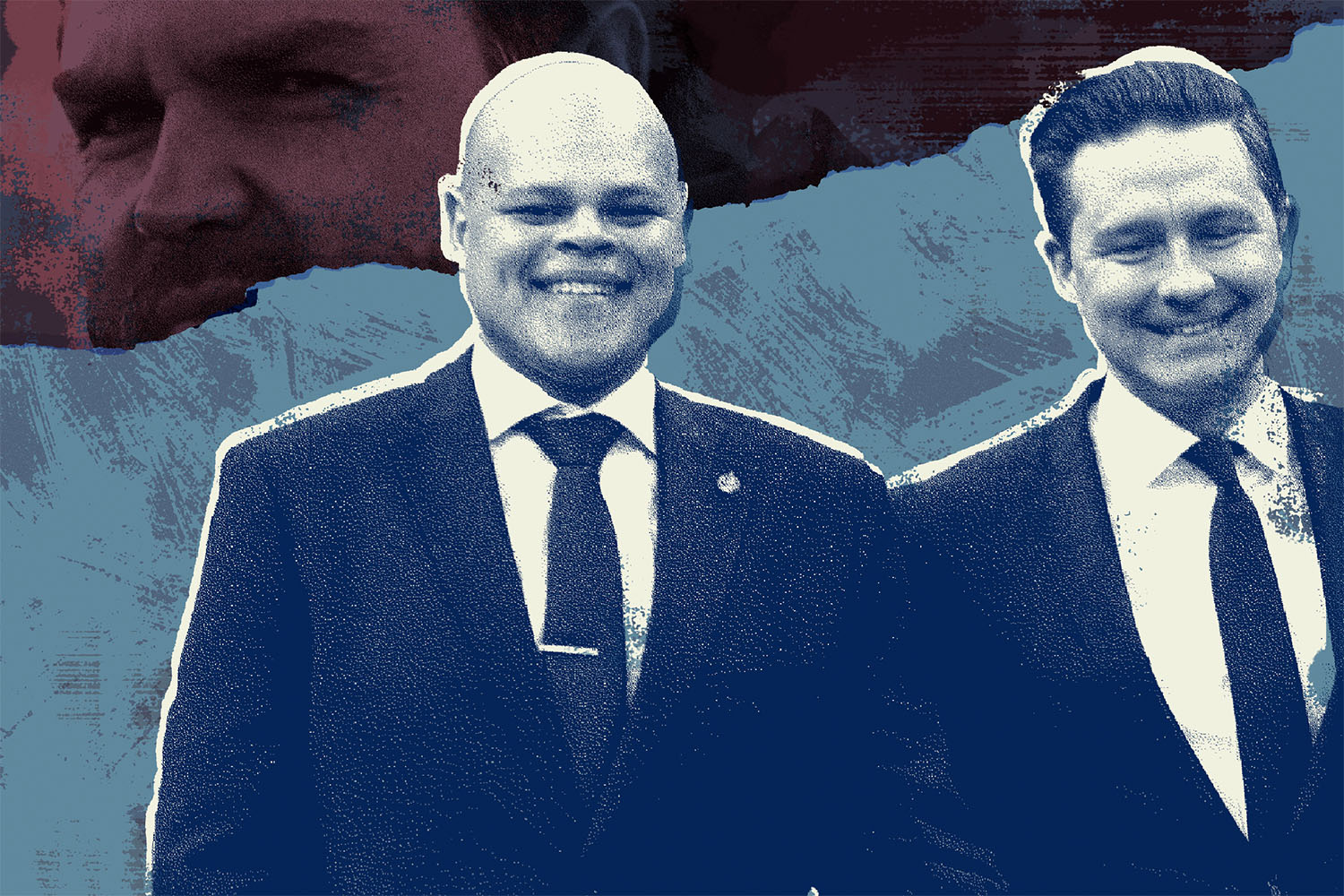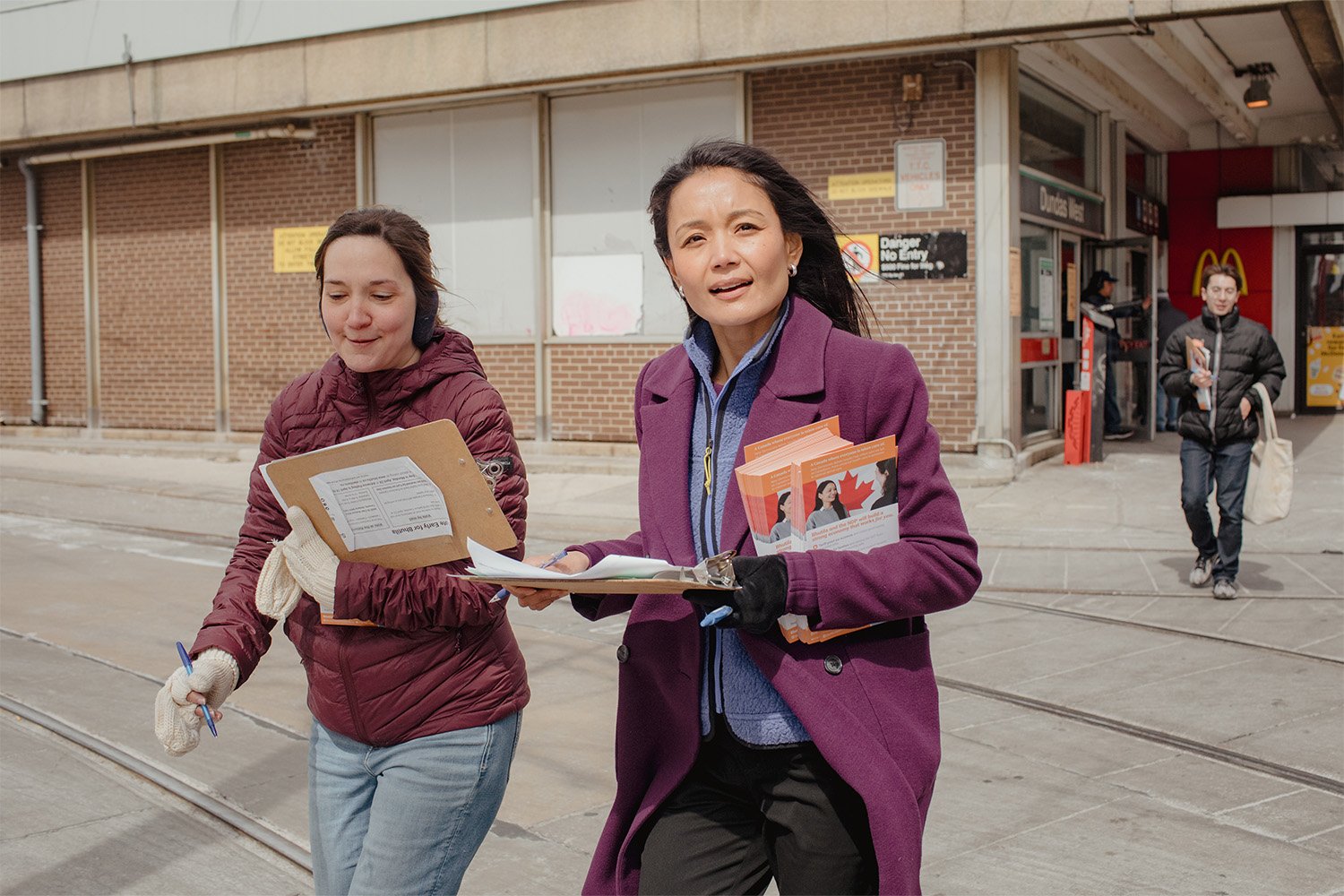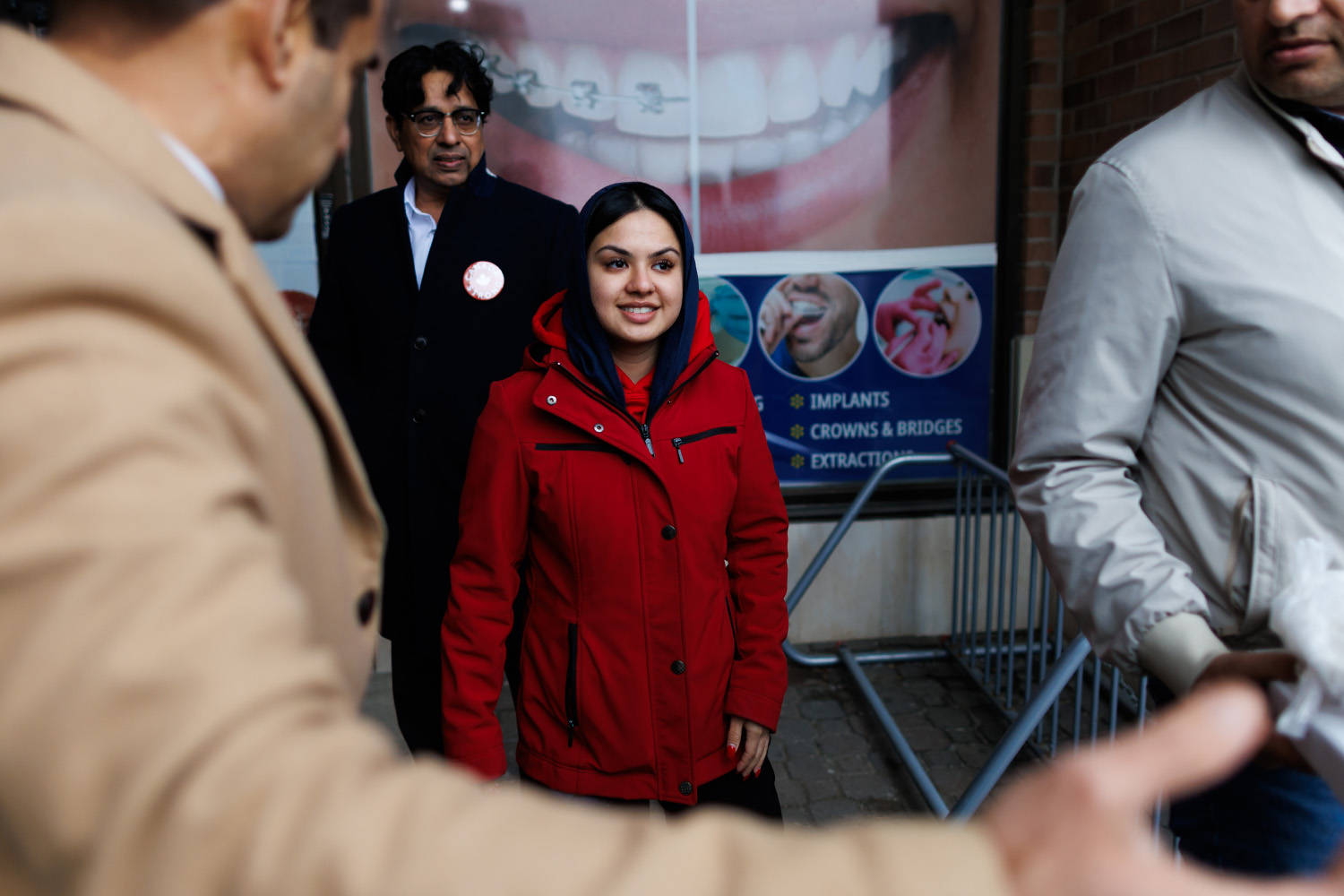
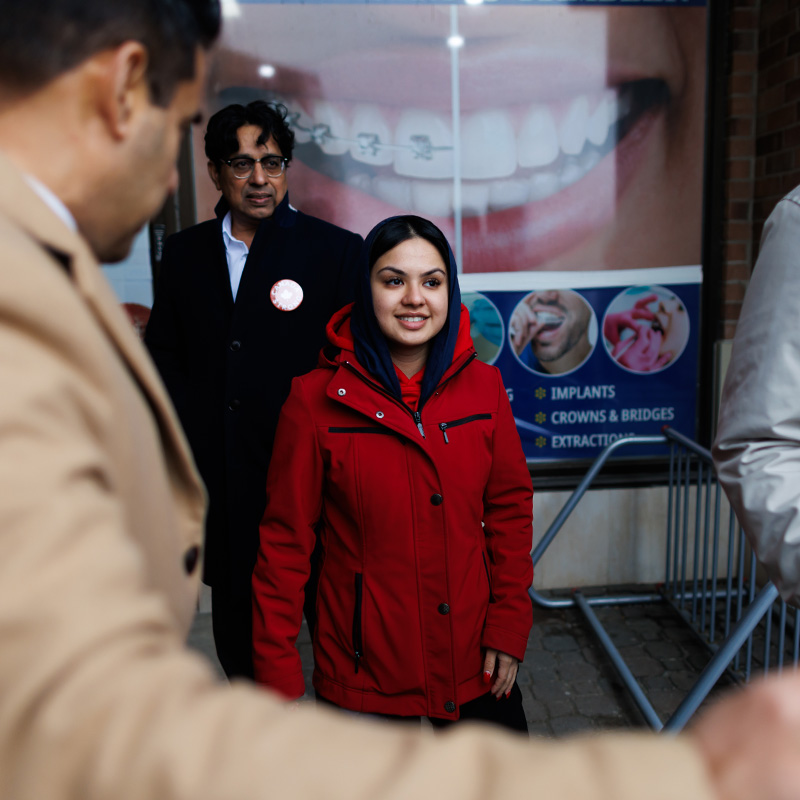
As Amandeep Sodhi approached Andre Ramkissoon’s west Brampton house on a warm April afternoon, her campaign manager stopped her to brief her about a phone call he’d had with the homeowner earlier that morning.
During the call, Ramkissoon had expressed his support for the Liberal Party, Sodhi’s campaign manager Ajay Rakhra told her. He wanted a red “Amandeep Sodhi” lawn sign. But he needed reassurance. He wasn’t interested in just hearing the party line, Rakhra said. He wanted to get to know her, and why she’s running.
It was an understandable request. As a first-time candidate—one without any name recognition and less than two years out of university—Sodhi is unknown to most voters in the Brampton Centre riding.
Running for Parliament, Sodhi said, had been a snap decision. Until this election, she explained, she had been working as a legal assistant at a law firm after graduating in 2023 with a bachelor’s degree in political science from King’s University College at Western University. She’d grown up attending Liberal Party functions with her father, who is an active member and long-time party supporter, and she’d always dreamed of one day getting into politics. So this winter, when she spotted an opening for nominees for Brampton Centre on the Liberal Party website, she went for it.
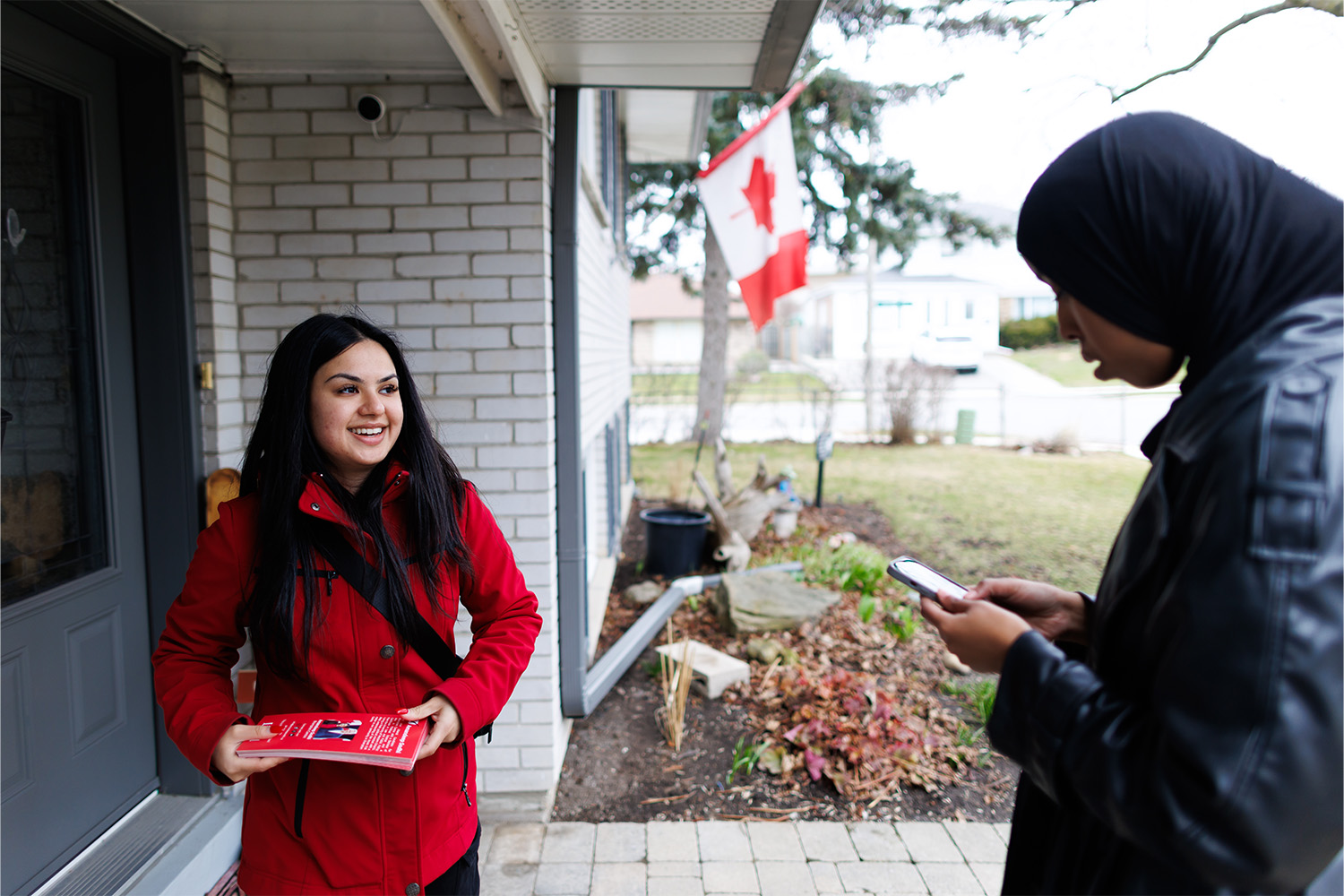
“I said, ‘You know what?…I’m just gonna do it,’” she said. “I’m definitely one of those people that [sic] just take the risk, and you know, see what happens.”
In late January, Sodhi was acclaimed as the Liberals’ Brampton Centre candidate.
Days into the federal race, her youth had already elicited remarks from constituents, surprised to see a petite, baby-faced 23-year-old running to be their Member of Parliament.
Her response, if trite, was confident and well-rehearsed.
“Yes, I’m young. But young people are the future of our country and our party, and this is the generation that’s going to lead Canada forward,” she explained.
Ramkissoon, who answered the door, had plenty of questions for her.
“I need to see, like, what is your knowledge of this area?” he said. Had she looked into the demographics of voters in this riding? Had she spoken with the area’s former Liberal MP?
Sodhi glanced over at her campaign manager, admitting she had been letting him take care of such discussions. Nevertheless, she answered that she was born and raised in Brampton, and had lived here most of her life—that is, apart from going away for university, and spending weekends and school breaks at her father’s in Caledon. (Her parents are separated.) And she had been listening to the concerns that residents shared with her at their doorsteps, she said—mostly that they were struggling with affordability and worried about crime.
Ramkissoon wasn’t asking her all of these questions because he was hesitant about voting Liberal, he told me later. He just wanted to suss her out.
“She’s a new candidate. She’s also not too long out of school. Being in federal politics is quite difficult,” he said. “Part of it was [to gauge] some level of qualification, like, ‘Okay, why are you doing this?’ You know, like, ‘What do you understand about our area?’”
The newly redrawn riding of Brampton Centre is a relatively small, irregular-shaped area that includes downtown Brampton—one of the fastest growing cities in the country and a key battleground in this federal election.
For the past decade, Brampton has reliably voted Liberal in federal elections. The Brampton Centre seat was previously held by Shafqat Ali, a Liberal backbencher who gained infamy in 2022 for remotely joining a parliamentary session from a toilet stall, and who is now running in the newly formed Brampton-Chinguacousy Park. The riding sits amid a broad swath of red encompassing much of the GTA—a stronghold that Conservatives have been desperate to break into for years.

If Sodhi has seemingly emerged from nowhere, her competitors are not well-known either. Taran Chahal, who’s on the Conservative Party ticket, is also running for office for the first time. His campaign signs could be seen plastered across the riding early this month, and he regularly posts photos and videos on Facebook of himself canvassing with a brigade of volunteers. (Chahal’s team did not respond to requests for an interview.)
Anil Boodhai, an ESL teacher for the Halton District School Board running for the NDP, is also a first-time candidate. Although his lack of signs, flyers, and a campaign office offered him considerably less visibility than his Liberal and Conservative rivals, Boodhai nevertheless said he was encouraged by the interest he was generating from knocking on doors.
It’s not unusual to see unrecognizable names on the ballot. Political parties often put up so-called “paper candidates”—essentially names without active campaigns—in ridings where they don’t expect to win.
Most people vote based on their preferred party or leader, not the local candidate, said Nelson Wiseman, professor emeritus in the department of political science at the University of Toronto. “I won’t say most people, but a lot of people who go to vote don’t know the name of the local candidate they’re going to vote for,” he said.
What makes the race for Brampton Centre remarkable, though, is that it’s a pivotal riding in what’s regarded as a bellwether region. Winning the 905 is crucial to winning the overall election. And in this riding, where all leading candidates are novices, whoever emerges as the victor will face a challenging initiation; the stakes in this fast-growing, manufacturing-heavy, and immigrant-rich region are enormous. Many of the key issues on which this election hinges have a direct and major impact on the people who live here. The decisions made on Parliament Hill by the next government—whether on cross-border trade, immigration, housing, or even public transit—will shape what the city looks like in years to come.
As diverse as Brampton is, with its large South Asian population, Brampton Centre is even more so. In this largely residential riding, there’s a mix of newcomers and descendants of immigrants from all over the world, from southern Europe to the West Indies.
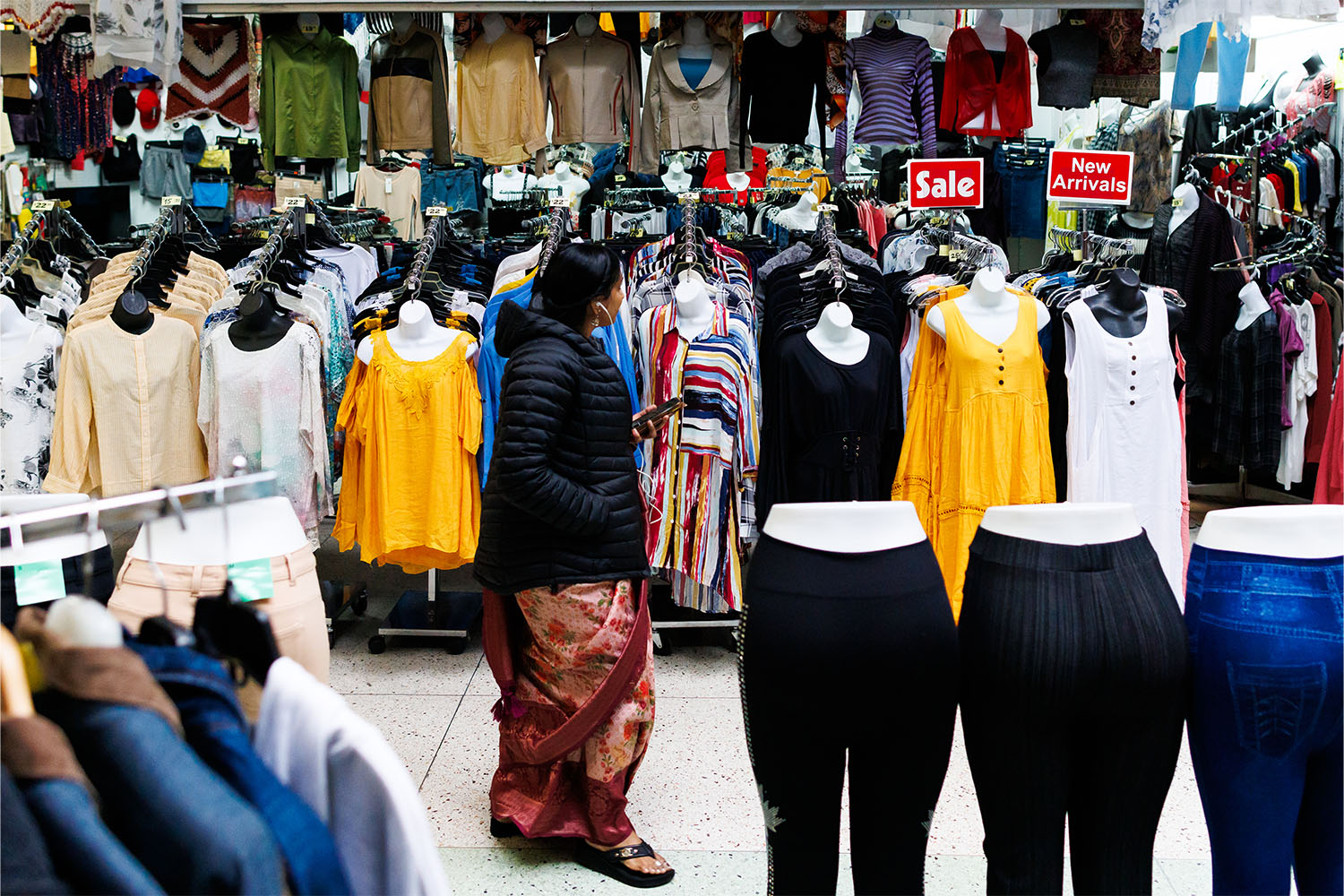
Over the past year, the federal government’s measures to significantly curb immigration have been keenly felt in the city, and by its post-secondary institutions. Algoma University is situated in the heart of Brampton’s quaint downtown core and Sheridan College’s Davis Campus is located just beyond Brampton Centre’s southern boundary.
“We have a disproportionate number of international students here now who are at real peril in terms of being able to stay in Canada, and who are being forced into more precarious work and living situations,” said Jaipaul Massey-Singh, chief executive officer of the Brampton Board of Trade.
Newcomers and international students have been unfairly blamed for a slew of problems at the local and national level, including crime, the rising cost of living, and a shortage of affordable housing, Massey-Singh said. Yet they play a key role in supporting the city’s downtown economy, where their labour and patronage keep small businesses afloat. Beyond the downtown core, Brampton’s manufacturing and logistics sectors also depend on international students to help maintain their workforce.
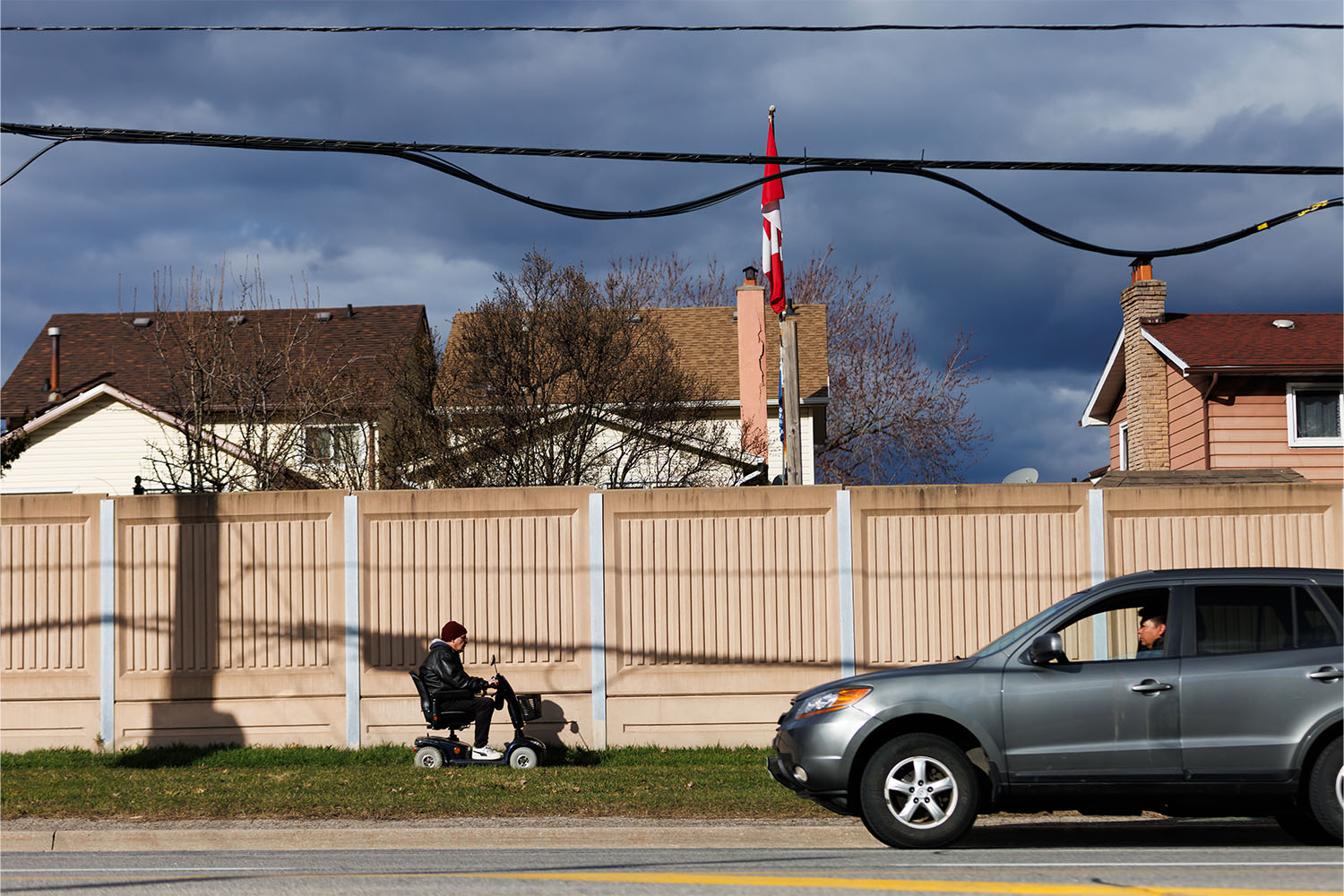
Besides federal immigration policies, many businesses across Brampton are also directly impacted by U.S. tariffs on Canadian-made goods. In his own neighbourhood in the northwest corner of Brampton Centre, Ramkissoon could point out neighbours who’ve had their work hours reduced by employers like the automotive manufacturer Stellantis.
“I don’t know how many of these folks will end up losing their jobs because of this [trade war],” Ramkissoon said.
While many Canadians have opted to “Buy Canadian,” the Brampton Board of Trade was promoting the message to support “Built in Brampton,” reflecting the fact that multinational companies like Coca-Cola and Amazon are major employers in the area.
For Massey-Singh, another top priority in this election is the need to address the housing crisis, which is driving young families north to cheaper towns like Innisfil. The Board of Trade was also looking for clarity from the parties on federal funding of public transit infrastructure—including for the Hurontario extension, which would bring the light rail line into downtown Brampton.
In discussions with candidates and residents, these broader, city-shaping issues were eclipsed by more personal concerns, like the rising cost of groceries or a sense that the city is becoming less safe.
“In general, criminals just seem to get arrested and they’re out again the next day,” said Brampton Centre resident Rita Kirby, who showed up to support Conservative candidate Taran Chahal at an event outside his First Gulf Boulevard campaign office early this month.
The question of how to deal with Donald Trump, which has dominated this election, was much less of a concern to her. Sure, she was annoyed that the president had implemented tariffs, she said. “But he’s looking out for his country.”
On that Sunday afternoon, the atmosphere in the party tent outside Chahal’s campaign office felt almost like a wedding. Supporters mingled as they tucked into plates of curry, rice, and Subway sandwiches. Many of them formed a receiving line to shake hands and have their photos taken with Chahal, who wore a blue jacket and open-collared white dress shirt in keeping with the Conservative Party’s colour scheme. (When I introduced myself to Chahal, he was congenial, but appeared too preoccupied to speak with me. Instead, I was introduced to his campaign manager, who was cheerful and friendly but did not return subsequent emailed requests for an interview.)
Federal Election 2025
For in-depth election coverage from across the GTA, sign up for our free newsletter
"*" indicates required fields
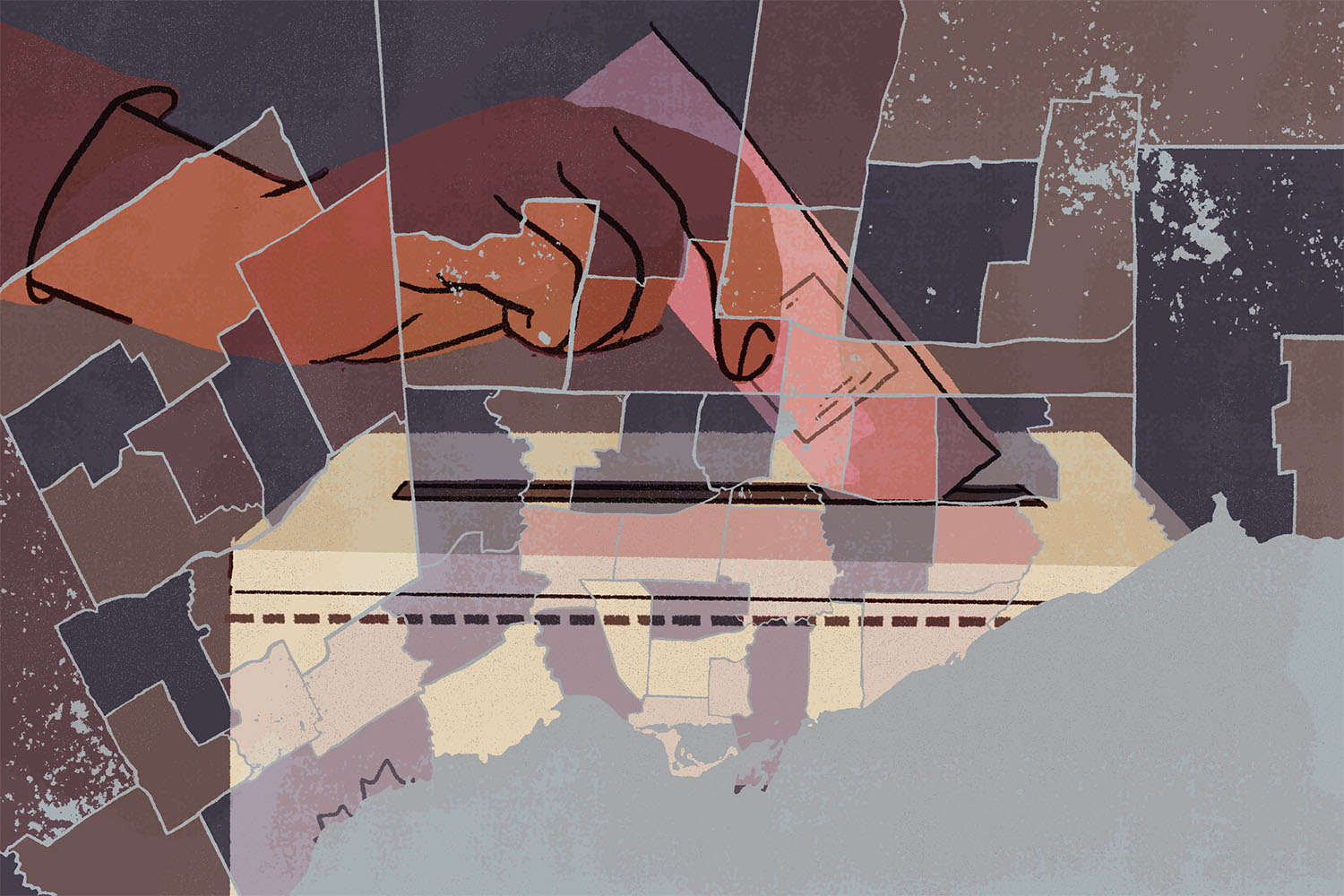
Polished, photogenic and flashing a brilliant smile as he addressed his guests, Chahal leaned into the perception that the quality of life for Bramptonians has declined over the past decade under the Liberals. In his speech, he vowed to “bring common sense back to government,” and harkened back to a time when his immigrant parents worked multiple jobs to allow him to obtain his CPA (Chartered Professional Accountant) credentials and an MBA from the Schulich School of Business. According to Ontario’s 2024 Sunshine List, Chahal was a manager of facilities and maintenance for the City of Brampton. His wife, he told the crowd, is a dentist.
For his parents, “the dream was that if you work hard, you follow the rules, success, liberty and a safe society was the promised land,” he said. But these days, he said, you could no longer leave your door unlocked or let your children walk home from school unattended.
“We need to bring that Canada back,” he said, “and that’s the main reason for running.”
For the NDP’s Anil Boodhai, running in this election was less about restoring some vision of the past than about listening to people’s needs, particularly those who are marginalized. Boodhai is a resident of Burlington, not Brampton Centre. He acknowledged that Brampton ridings tend to vote Liberal, and he expected his campaign to be “an uphill battle.” But he thought it was important to bring some balance to the election. “We don’t want to see a two-party system all the time. I want to show people that there are other options.”
Sodhi, meanwhile, said her priorities are to empower women and young people. Young people, she said, need to be more engaged in politics and more aware of what’s happening in their communities. She added that she wants them to exercise their right to vote—“and that by doing so, they’re making a change, right?”
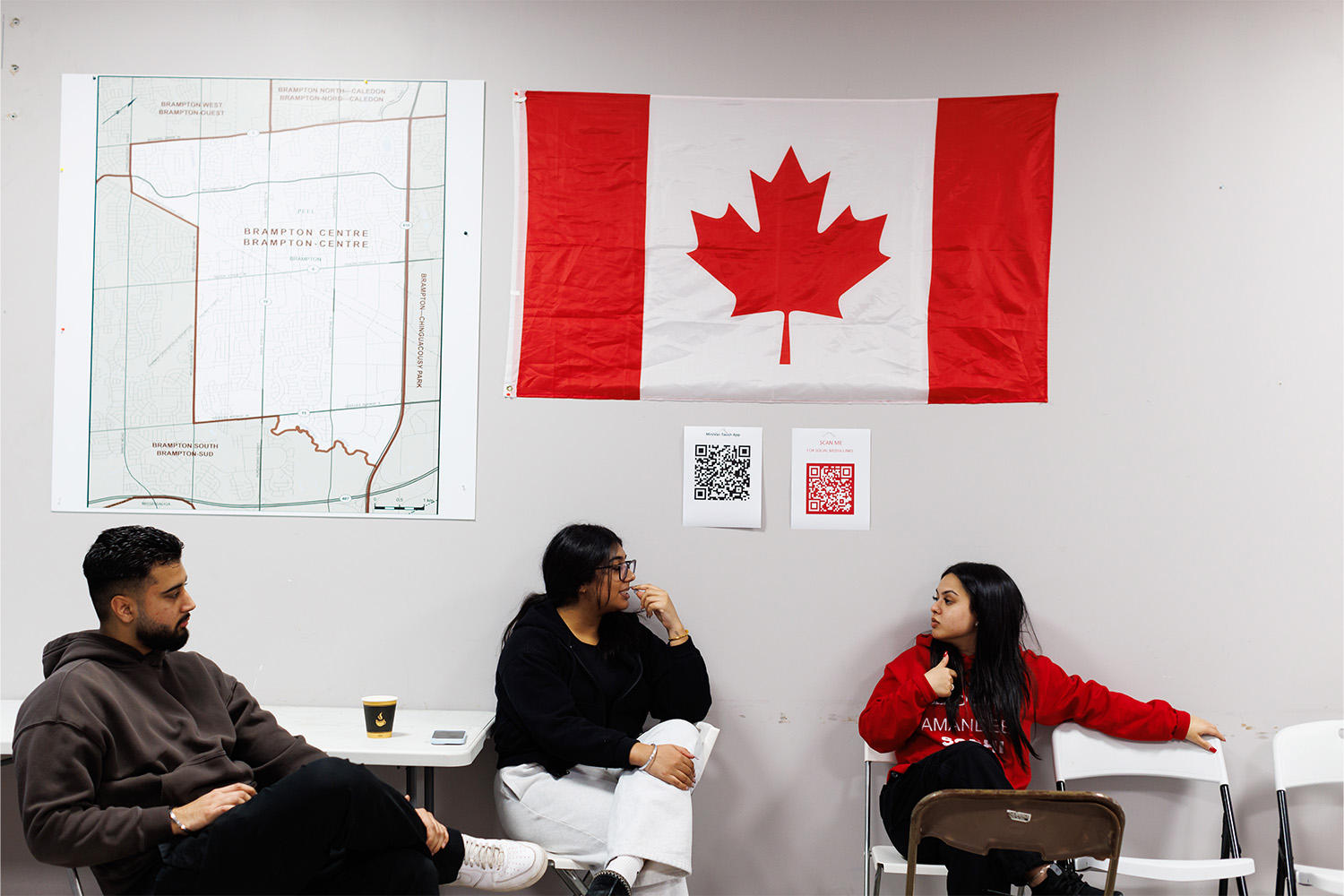
Sodhi, who turns 24 later this year, isn’t much younger than Pierre Poilievre was when he was first elected to Parliament in 2004. And while there are obvious advantages for parties to have a candidate with some prior experience, whether at the school board level, or as a city counselor or provincial candidate, being a rookie isn’t necessarily a bad thing, according to Trent University professor Cristine de Clercy. Even the most seasoned, star politicians had to start from somewhere. And in our model of democracy, it’s good to have members of Parliament from a wide range of backgrounds and life experiences, de Clercy said.
Sodhi possesses an impressive air of confidence and self-assurance. But unlike the leader of her rival party, she has no desire to remain in politics into her 40s and 50s.
“Honestly, probably I’d want to be retired, enjoying life,” she said. She envisioned herself perhaps going to law school in her 30s—“or raising a family and not doing much at all.”
By then, she said, she hoped an even younger generation would take up the mantle.
The Local’s Federal Election 2025 coverage is supported in part by our readers and by the Covering Canada: Election 2025 Fund.
